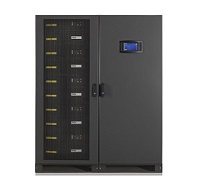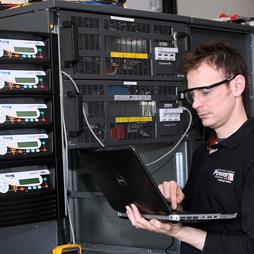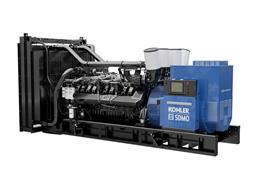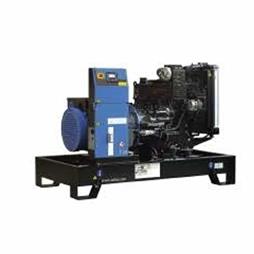Factors to consider when running generators with UPS systems
18-10-2016
Factors to consider when running generators with UPS systems
Posted on 16th August 2016
Most businesses of any size now rely on clean, continuous power from an uninterruptible power supply (UPS) to prevent loss of service, data loss and damage to sensitive IT and communications equipment. A correctly specified UPS system from a reputable supplier will provide this power protection during short-term power disturbances and blackouts, but is not designed to deliver backup power indefinitely. If a business’s IT must remain online rather than shutting down gracefully during an extended blackout, a standby generator will be needed to complement the UPS system.
In this article, Alan Luscombe discusses the factors to be considered when adding a generator to UPS power systems. These range from designing in electrical compatibility to addressing environmental and physical constraints.
While UPS systems today provide excellent protection from utility mains transients and short-term blackouts, they’re not a complete solution for applications that must remain online 24/7, without interruption. A power outage that exceeds the UPS battery autonomy is always possible, yet a system shutdown, even if managed gracefully, is not acceptable. Additionally, running the application from the UPS battery is pointless if there is no power for the air conditioning system that cools it.
The solution is to complement the UPS system with a back up generator that starts up if the battery autonomy is threatened, then runs indefinitely if necessary. The UPS bridges the power gap between the mains failing, and the standby generator starting up and reaching synchronisation. It also cleans all power, whether from the mains or the generator.
A number of factors apply when planning a generator installation; these relate to maintenance and fuelling, compatibility with the UPS and power system, correct generator sizing, and physical integration into the target environment. All must be taken into account to ensure a generator/UPS pair that truly guarantees uninterrupted availability, even during extended power outages.
Generator characteristics and care
A generator comprises a fuel supply, an engine and an alternator. The fuel can be gas or diesel, although gas-powered generators are used mainly for combined heat and power (CHP) applications. Diesel, used for both base load and standby applications, is the usual complement to UPS systems. Generator engines resemble those found in large trucks, and have the same maintenance requirements. An adequate fuel supply should always be available, together with a healthy battery for reliable starting. Regular generator maintenance is essential, with frequent checks on oil and coolant levels.
T Series Standby Generator
Fig.1: UPSL PowerWAVE T Series standby generator
The alternator converts the engine’s mechanical power into an AC electrical supply, usually at either 230 V (single-phase) or 400 V (three-phase) levels; these levels depend on how the alternator is wound. Output voltage amplitude and stability are controlled by an Automatic Voltage Regulator (AVR), while its frequency – usually 50 Hz in the UK – is determined by engine speed. The speed/frequency relationship usually depends on the alternator design; typically an alternator speed of 1500 rpm equates to a 50 Hz output frequency. Engine speed and output frequency are controlled by a governor which regulates the amount of fuel reaching the engine. More fuel means higher engine speed and electrical output frequency.
Simple, mechanical governors based on springs and spinning weights are available as a low-cost way of fuel supply regulation, however, they lack the fast response and frequency regulation stability essential for use with UPSs. Instead, stanby generators intended for use with UPS systems almost always rely on electronic governors, which operate by counting the teeth on the alternator flywheel and regulating the fuel accordingly. They are highly responsive and offer very stable engine speed regulation.
Compatibility with UPS sytems
Achieving tight engine speed control is critical in these applications, as it allows synchronisation between the UPS system and the back up generator. Synchronisation problems between the UPS and the utility mains supply are rare because utility companies’ generators are huge, so their inertia can absorb any sudden increase in load. By contrast, a small local generator subjected to the same load change will slow down until the governor compensates.
Overall, the generator’s frequency range may be too wide for the UPS system to accept. In the worst case, synchronisation may not be possible, either because the frequency is out of limits or because its rate of change (slew rate) is too fast for the UPS to follow without endangering the load. If this happens, most UPS sytems will flag an alarm to warn the operator that if a fault occurs the load will not be transferred from the UPS to the raw generator feed.
These problems can be prevented by ensuring that the generator manufacturer is aware of their product’s intended use with UPSs, and fully testing it during commissioning. As mentioned, the use of electronic governors will minimise or completely eliminate potential problems.
Generators also need to be prepared in other ways for their standby power source role. They must always be ready to start on demand, as mains power failures are unpredictable. Accordingly, they must always be kept warm, have a fully-charged battery and sufficient fuel. They must be aware of mains failure and restoration status so that they can start and stop as appropriate. This status information is usually supplied by signals from an Automatic Mains Failure (AMF) panel as shown in Fig.2. This shows arrangements not only for detection but also for switching to the standby generator and back during mains failure and restoration.
Fig 9.3 - Switching To And From Standby Generator
Fig.2: Typical protected power installation with Mains Failure Detection and Change Over
.
Nuisance starts every time the mains is disturbed must be avoided, so the AMF signal is usually set to operate only after an extended mains failure time; delays of 2 s to 10 s are typical. Stopping the standby generator and switching the UPS system back to mains as soon as supply is restored must equally be avoided, as the underlying fault may not have been cleared. Accordingly, most AMF controlled generators continue running for at least two minutes after detecting that mains have been restored.
If a mains failure is detected, there is an inevitable time delay before the backup generator can be started up and synchronised. The UPS system covers this by powering the critical load from its battery, then switching to generator power when available. It also uses backup generator power to recharge the depleted battery. Similarly, the UPS system uses battery power to maintain an uninterrupted power supply during transfer back to mains, then uses the mains power to recharge its batteries again.
Planners should also consider how to switch the neutral conductor during mains changeovers. 4-pole switching is normal in the UK, as short interruptions in the neutral plane are accepted, due to today’s proliferation of on-site generators. The solution finally chosen depends on the requirements of both the UPS system and other connected loads, and on local electricity supply regulations.
Generator sizing
Generator sizing, as well as compatibility, is important. For example, the generator should usually accommodate air conditioning, emergency lighting, alarm and communications as without these services, the UPS load and its operators will be at risk of damage or injury. As a very approximate ‘rule of thumb’ generators should be sized to:
1.5 x the nominal UPS capacity for the transformerless UPS systems usually found in today’s data centres and IT rooms
3 x the nominal air conditioning running capacity
Capacities of other loads to be protected can be found from the manufacturers’ specifications, or by measuring using a current clamp. The UPS and generator manufacturers should be consulted for more accurate sizing advice before finally committing to purchase.
In some applications, generators are run continuously. In others, though, they are a standby generator resource that only runs occasionally. This reduced demand and stress allows a ‘Standby’ rating, which is typically 10% higher than the ‘Continuous’ rating. However, when used for power protection, backup generators can be started up at any time and for any duration. Because of this unpredictable demand, choosing the more conservative ‘Continuous’ rating is recommended.
Ensuring environmental acceptability
While ensuring that the generator is UPS-compatible and fit for its load, other measures are essential to ensure its environmental acceptability. Fuel oil storage, for example, is subject to legal regulation under most circumstances in most parts of the UK, with a requirement for double-bunding to prevent oil/fuel escaping into the water environment. A standby generator typically sits on a double-bunded base tank containing fuel for between eight and 24 hours’ runtime.
Because generators may start and continue running at night as well as by day, acoustic housings with suitable noise attenuation ratings should be used to avoid unacceptable disturbance to the workplace or adjacent properties. Generators also produce considerable heat, and usually use air cooling to remove it. Accordingly, sufficient cooling air should always be available, ideally by citing the generator outdoors in a weatherproof, acoustic enclosure.
Correct management of exhaust fumes is also essential, with care taken to ensure safe limiting and venting. Specialist advice is needed if exhaust pipes pass through, or are attached to a building.
Co-operation with several authorities is necessary; this includes obtaining local authority planning permission, informing the local fire officer of on-site fuel storage and advising the local electricity utility company of the generator’s installation.
Conclusions
When enterprises depend on an always-available IT and communications resource for 24/7 online transaction processing, using a generator’s indefinite backup capability to complement the UPS system’s immediate protection role becomes essential. In this article, we have reviewed the factors needed for a successful generator/UPS pair. These cover setting up the generator correctly, ensuring design compatibility with the UPS system, sizing it correctly for its application and suitability for its physical environment.
To be absolutely sure that the complete power protection installation will perform as expected without compromise, partnering with a well-established UPS supplier offering extensive experience of installing UPSs, generators and integrated power systems is highly recommended.






